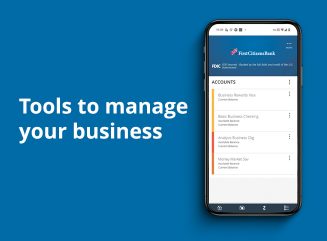Digital banking for business
Seamlessly access all of your accounts from one place with First Citizens Digital Banking for business.

Control your portfolio
Invest how you want, when you want, in real time with Self-Directed Investing.

Digital banking for business
Seamlessly access all of your accounts from one place with First Citizens Digital Banking for business.
See how we're supporting companies
We're committed to serving companies as they expand and succeed. The proof is in our success stories.
Q4 Quarterly Market Review: Available now
The Making Sense team reviews changes in the market during Q4 2025.
The size of American households, it seems, is growing. According to a Pew Research Center study of US Census data, the size of American households began to grow from 2010 through 2019 for the first time in at least 160 years, fueled by adult children and elder parents moving in with standard nuclear families of adults with children.

By 2019, about 20% of American households were considered shared households, according to the Pew report. And 67% of 35- to 54-year-olds lived in a household with three or more people by 2017, up from 64% in 2010.
Financially, that's not always a bad thing. In 2018, only 6% of families with at least one adult child between the ages of 25 to 34 in the household lived in poverty. That number would have been 11.5% otherwise, the Census Bureau estimated, largely because adult children can bring in an extra paycheck and help care for younger children. But the scene for growing families isn't always rosy. An Urban Institute study (PDF) in 2016 found that 38% of families with children under 18 at home were struggling to get by while only 33% with no children felt the same strain.
Clearly, the size of your family and the shape of it are important to the family's finances. Here are five ways you can adjust as your family grows or shrinks.
For families with young children, the high cost of food, healthcare and especially child care can exert considerable pressure even on middle-class two-income homes.
Keeping a handle on the day-to-day budget is crucial—something that can be accomplished with a simple budget calculator and the time and willingness to keep a sharp eye on your credit card balances and online banking accounts.
What's often overlooked, though, is the need for early planning.
Even if you don't yet feel wealthy, your family's growing years are the time to create a financial plan. A financial professional can help you talk through your decisions and find the right tools to accomplish whatever you need, whether it's home renovation lending, a mortgage, insurance, retirement accounts or a way to cover the cost of a big vacation.
A good plan will also help you on the other end when your household is shrinking. Should you funnel more money into retirement at that point? Shift college savings from one relative to another? Renovate the house or buy a new one to expand office and recreation space instead of bedrooms? Having a plan and a trusted advisor can help you sift through your options and possibly even see the choices you may want to make more clearly.
Are more children on the way, or is an elderly parent or adult child moving in with you? Either way you'll likely need more living space. With the current housing inventory shortage, you may want to consider whether you want to buy a bigger house or renovate your own. Once you assess how much more space you need, you can use calculators to compare the potential cost of a mortgage to the cost of a home renovation loan.
If your family is shrinking—perhaps the kids have moved out and you no longer need such a big house—you may want to think about selling your home. This is a seller's market, and you'll likely get plenty of strong offers. Of course, you'll also need to consider where you'll move to and whether it's better to rent or own your new home or consider a development that's specifically geared toward seniors.
Along with your living quarters, you may want to reconsider how you get around. You may need a bigger car to accommodate your growing family, or perhaps you want something smaller if it's just you and a spouse.
The biggest question here, aside from what to get, is whether to buy or lease. Leasing will often get you a more expensive vehicle for less per month, but you won't own it and the expenses can be high if you exceed your contract's mileage limits or other restrictions. Owning is less complex and may give you more freedom. A lease-or-buy calculator can help you make the choice.
Early in your family's life, you'll need to protect income if one of the breadwinners gets seriously hurt or dies. Disability insurance—often offered by employers as a benefit—can pay at least the bulk of your bills if you're injured or ill. Life insurance can ensure you have enough money to cover the mortgage payment and other debts and maybe cover future needs and desires like paying for daycare or sending the kids to college.
That's all pretty obvious while the family's growing and you're working. But what do you need when it's just you or you and your spouse?
If you lack enough retirement savings to support your spouse if you pass on, you should probably consider keeping some life insurance in place. If that's not the case, you can reexamine your insurance needs and consider reducing or eliminating coverage.
If you bought a term life policy when you were younger, it'll likely expire after your family is grown. If you no longer need the coverage, that's great—you also don't have to pay any more premiums. If, on the other hand, you're still paying for a whole life or universal policy but you no longer need the death benefit, you may be able to tap your policy for its cash value through withdrawals or loans. Any decision you make regarding your life insurance can be fraught with complications, so it's important that you consult with your tax and insurance professionals before you make any moves.
As you age, your needs for different kinds of insurance may also change.
If you're retired, disability insurance won't do you much good as you have no working income to protect. But a long-term care policy might prevent a severe drain on your savings if you develop the need for extended—and expensive—assisted living or home nursing care.
If you're fully funding your retirement needs, you've taken care of your insurance and your house is in order, you may want to set aside money to help a child or grandchild through college or trade school. With average tuition costs sailing over $43,700 for private colleges and $28,200 for public schools in the 2021-2022 school year, your kids may need all the help they can get.
You can consider investing in one of the 529 college education plans offered by 49 states and the District of Columbia. You won't get a federal tax break for contributions, but contributions are free of state taxes in some states and your investments grow both state and federal tax-free. Once school starts, you can withdraw funds tax-free as long as they're spent on qualified education expenses such as tuition, books, and room and board.
You could also consider a Roth IRA. With a Roth, you pay income taxes on contributions in the year in which you make them, but your investments grow tax-free and you can withdraw them tax-free and penalty-free if you're over 59 1/2 and your first investment in a Roth occurred at least five years before your first withdrawal.
All this can make a Roth an acceptable option for grandparents or older parents who've reached 59 1/2. Other than reducing your retirement funds, the only significant drawback of using Roth money at that point for education is that it counts against you in financial aid calculations.
If you're younger than 59 1/2, though, you'll need to proceed with more caution. Roth contributions can always be withdrawn tax-free and penalty-free, since that money has already been taxed. But any withdrawn gains could face a 10% early withdrawal penalty and be liable to income taxes if you fail to follow the tight rules that govern the education exemption.
If you're under 59 1/2, the exemption allows you to avoid the 10% early withdrawal penalty if you spend the money solely on education expenses. But you must pay income tax on any investment gains you withdraw, and you must spend the funds on expenses incurred in the same year as your withdrawal. Otherwise, the penalty kicks in along with the tax.
What happens if a particular child doesn't want to go to college or trade school once they reach that age? Or your intended beneficiary doesn't spend as much as you thought they would?
With a Roth, you can simply keep the money for retirement. If you're over 59 1/2, you can spend your tax-free withdrawals on anyone, keeping potential gift taxes in mind. Or, if you're younger, you can use the education exemption to fund education expenses for another child, grandchild, yourself or your spouse.
A 529 plan can also be transferred to a broad range of close relatives, including children, grandchildren, nieces, nephews or their spouses. But the plan can only be used for one person at a time, and if you use it for retirement instead of education expenses, you'll face a 10% penalty plus income taxes on your withdrawals.



Insurance products are not insured by the FDIC or any federal government agency and are not a deposit or other obligation of, or guaranteed by, any bank or bank affiliate.
Insurance products offered in California are offered by First Citizens Investor Services, Inc., d.b.a. FCIS Insurance Solutions, Agency #6001908.
This material is for informational purposes only and is not intended to be an offer, specific investment strategy, recommendation or solicitation to purchase or sell any security or insurance product, and should not be construed as legal, tax or accounting advice. Please consult with your legal or tax advisor regarding the particular facts and circumstances of your situation prior to making any financial decision. While we believe that the information presented is from reliable sources, we do not represent, warrant or guarantee that it is accurate or complete.
Third parties mentioned are not affiliated with First-Citizens Bank & Trust Company.
Links to third-party websites may have a privacy policy different from First Citizens Bank and may provide less security than this website. First Citizens Bank and its affiliates are not responsible for the products, services and content on any third-party website.
First Citizens Bank is a Member FDIC and an Equal Housing Lender icon: sys-ehl.
NMLSR ID 503941

Treasury & Cash Management
Electronic Bill Presentment & Payment
Investment & Retirement Services
Community Association Banking
Equipment Financing & Leasing
Credit Cards
Merchant Services
Email Us
Please select the option that best matches your needs.
Customers with account-related questions who aren't enrolled in Digital Banking or who would prefer to talk with someone can call us directly.